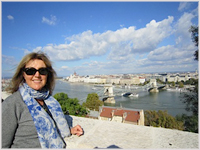 Known for the past 20 years as the Budapest Autumn Festival and recently renamed Cafe Budapest, this festival celebrates the achievements of contemporary art, design and culture in Hungary. The October Cafe Budapest Festival offers a varied programme of around 250 events, across 47 venues, (a third of which are free) for lovers of contemporary art: music, dance, theatre, film and photography. I was lucky enough to be invited for a long weekend in this beautiful city to experience a few of the activities on offer – difficult to choose from the wide range of events – along with the thermal spas, wonderful restaurants and wine. But egged on by my husband we managed!
Known for the past 20 years as the Budapest Autumn Festival and recently renamed Cafe Budapest, this festival celebrates the achievements of contemporary art, design and culture in Hungary. The October Cafe Budapest Festival offers a varied programme of around 250 events, across 47 venues, (a third of which are free) for lovers of contemporary art: music, dance, theatre, film and photography. I was lucky enough to be invited for a long weekend in this beautiful city to experience a few of the activities on offer – difficult to choose from the wide range of events – along with the thermal spas, wonderful restaurants and wine. But egged on by my husband we managed!
Historically it seems everyone’s been to Budapest: Celts; Mongols; Atilla the Hun; Turks; Romans (of course) to name but a few and, more recently, the Austrians and Germans. As a result, Budapest vibrantly reflects its past through these many influences but is also a city that keeps re-inventing itself and is currently in the process of renovating its historical buildings in celebration of its past and building cutting-edge new designs with a firm nod to the future. Until 140 years ago Budapest was two cities: Buda and Pest, located opposite each other across the majestic Danube. Buda with its plethora of stunning World Heritage buildings and Pest the ‘downtown’ area of the city, though not without its own share of stunning architecture and must-see-places to visit. For lovers of culture and history this Central European city is very hard to beat.
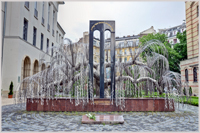 On our first day we enjoyed a guided four-hour walking tour where we explored many hidden areas of the city, particularly around the Old Jewish quarter. The area is generally bustling with locals and (in summer) tourists, but walk a few streets away from the main drag, and it’s another world. We wandered through large wooden doors into courtyards of houses and apartments: if buildings could speak they would have spoken volumes. The Dohany Street synagogue, the largest in Europe, built around 1859, formed part of the Budapest ghetto in WW2 and is spectacular in its design. With an updated holocaust memorial garden around a stunning modern sculptural tree, sightseeing in the city would be incomplete without a visit here.
On our first day we enjoyed a guided four-hour walking tour where we explored many hidden areas of the city, particularly around the Old Jewish quarter. The area is generally bustling with locals and (in summer) tourists, but walk a few streets away from the main drag, and it’s another world. We wandered through large wooden doors into courtyards of houses and apartments: if buildings could speak they would have spoken volumes. The Dohany Street synagogue, the largest in Europe, built around 1859, formed part of the Budapest ghetto in WW2 and is spectacular in its design. With an updated holocaust memorial garden around a stunning modern sculptural tree, sightseeing in the city would be incomplete without a visit here.
But back to the Budapest Festival. Jazz, chamber music, pop, rock, cabaret, theatre, poetry, stand-up comedy and techno music – ooh what to choose?
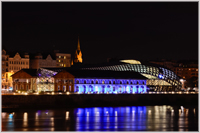 With limited time we were only able to sample a little of what was on offer. We chose to visit a design exhibition at Balna, a recently opened building that combines architecture of different eras – a historical brick building and a computer designed metal glass shell – to stunning effect, specifically built to showcase art and design exhibitions, together with shops, restaurants and bars. The exhibition celebrated the best of modern art and craft including a quirky coffin covered with consumer brand labels, such as ‘Every Little Helps’ – a novel approach of meeting funeral expenses in the future perhaps?
With limited time we were only able to sample a little of what was on offer. We chose to visit a design exhibition at Balna, a recently opened building that combines architecture of different eras – a historical brick building and a computer designed metal glass shell – to stunning effect, specifically built to showcase art and design exhibitions, together with shops, restaurants and bars. The exhibition celebrated the best of modern art and craft including a quirky coffin covered with consumer brand labels, such as ‘Every Little Helps’ – a novel approach of meeting funeral expenses in the future perhaps?
In the evening we opted for a celebration of contemporary and chamber music at the Budapest Music Centre. Music included Schubert and Beethoven sonatas as well as some contemporary pieces and a performance by the world’s foremost clarinet player, Jorg Widmann, in the intimate atmosphere of the Music Centre. World-class performers from across the globe take part in the festival, so you can see a wide range of acts from exceptionally accomplished artists for a fraction of the cost you would pay in the UK. The arts are clearly an important facet of Hungarian life at prices within reach of most pockets. Coming from London, where ticket costs are extremely high, Budapest is an affordable delight for all culture vultures where you really do get a lot for your Hungarian Forint.
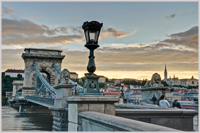 The Cafe Budapest Festival in October is a fantastic time to visit the city for the sheer plethora of artistic and cultural activities available. However, the cultural activities available year round in the city are also impressive and very reasonably priced. Our Saturday night we treated ourselves to the opera. Tickets for Cosi Fan Tutte at the stunning Opera House (7th row in the central stalls) were £37 each. By comparison, similar tickets at Covent Garden would be in the region of £200 each. With low-cost return flights booked well in advance, plus two nights in a reasonable 3* or 4* hotel, you can see it makes sense to get your opera fix in Budapest!
The Cafe Budapest Festival in October is a fantastic time to visit the city for the sheer plethora of artistic and cultural activities available. However, the cultural activities available year round in the city are also impressive and very reasonably priced. Our Saturday night we treated ourselves to the opera. Tickets for Cosi Fan Tutte at the stunning Opera House (7th row in the central stalls) were £37 each. By comparison, similar tickets at Covent Garden would be in the region of £200 each. With low-cost return flights booked well in advance, plus two nights in a reasonable 3* or 4* hotel, you can see it makes sense to get your opera fix in Budapest!
One thing that I didn’t know anything about was Hungarian food and wine. Like most landlocked Central European countries, meat dishes and pastries, (particularly strudel) are typical, with a small supply of river fish and generally not a huge choice for vegetarians. However, I was pleasantly surprised to find a wide variety of savoury and sweet strudels at the Strudel Cafe, whose mission it is to preserve and hand down the original method of strudel-making. Several strudels later, I could confirm that they have exceeded their mission.
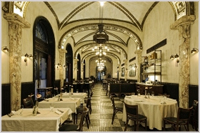 We ate wonderful food in cafes as well as traditional, trendy, and upmarket restaurants. Surrounded by historical architecture or funky designs, most restaurants had live music to serenade diners at both lunch and dinner. A memorable lunch in the garden at Pierrot whilst the pianist played; a delicious supper at the elegant Callas Restaurant with salon music; another supper in the vibrant Menza, modelled on Budapest’s 1960s coffee bars to the backdrop of a great soundtrack; afternoon tea at the Parisi cafe, in the neo-Renaissance opulence of what was previously a ballroom, under gold, frescoed ceilings and chandeliers, to the accompaniment of a violinist, was the metaphorical icing on the cake.
We ate wonderful food in cafes as well as traditional, trendy, and upmarket restaurants. Surrounded by historical architecture or funky designs, most restaurants had live music to serenade diners at both lunch and dinner. A memorable lunch in the garden at Pierrot whilst the pianist played; a delicious supper at the elegant Callas Restaurant with salon music; another supper in the vibrant Menza, modelled on Budapest’s 1960s coffee bars to the backdrop of a great soundtrack; afternoon tea at the Parisi cafe, in the neo-Renaissance opulence of what was previously a ballroom, under gold, frescoed ceilings and chandeliers, to the accompaniment of a violinist, was the metaphorical icing on the cake.
Hungarian wine is well worth a mention. We loved it! We had excellent wines that would definitely give the best French and New World wines a run for their money and, for the quality, quite cheap in comparison. Although the world-famous Hungarian sweet dessert wine, Tokja, commands a pretty hefty price, my husband (more knowledgeable than I am on this subject!) informed me it is still a good buy.
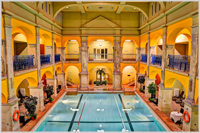 Famous for its thermal springs Budapest has held the title ‘City of Spas” since 1934. With more thermal springs than any other capital city in the world, experiencing one of the many public spas is a must. We visited two during our short stay. The oldest, Rudas, was built over 500 years ago. With the original octagonal pool of the Turkish bath at its core, it is now integrated with two additional complexes including a brand new one complete with outdoor rooftop Jacuzzi, sun-loungers and café overlooking the Danube. Lazing under the dome of the historical, octagonal, bath with shafts of sunlight glinting through the coloured glass skylights before viewing the Danube and Budapest skyline from the relaxing comfort of the Jacuzzi was a magical experience. The largest spa, Szechenyi, one of Europe’s largest bath complexes, has18 indoor thermal bathing pools and 3 large outdoor pools. Whilst it was fairly busy with locals, as well as tourists, enjoying outside bathing, it was not too crowded and was a very pleasant way to spend a lazy sunny Sunday afternoon. Luxuriating in a warm thermal pool, an azure blue sky, surrounded by ornate neo-classical buildings, autumnal sunshine – a perfect treat for our last day in the city. After using the steam rooms and thermal pools we floated out of the spa ready for some more sightseeing.
Famous for its thermal springs Budapest has held the title ‘City of Spas” since 1934. With more thermal springs than any other capital city in the world, experiencing one of the many public spas is a must. We visited two during our short stay. The oldest, Rudas, was built over 500 years ago. With the original octagonal pool of the Turkish bath at its core, it is now integrated with two additional complexes including a brand new one complete with outdoor rooftop Jacuzzi, sun-loungers and café overlooking the Danube. Lazing under the dome of the historical, octagonal, bath with shafts of sunlight glinting through the coloured glass skylights before viewing the Danube and Budapest skyline from the relaxing comfort of the Jacuzzi was a magical experience. The largest spa, Szechenyi, one of Europe’s largest bath complexes, has18 indoor thermal bathing pools and 3 large outdoor pools. Whilst it was fairly busy with locals, as well as tourists, enjoying outside bathing, it was not too crowded and was a very pleasant way to spend a lazy sunny Sunday afternoon. Luxuriating in a warm thermal pool, an azure blue sky, surrounded by ornate neo-classical buildings, autumnal sunshine – a perfect treat for our last day in the city. After using the steam rooms and thermal pools we floated out of the spa ready for some more sightseeing.
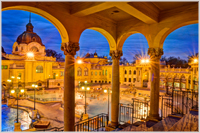 Getting around central Budapest is very easy, particularly if you buy the Budapest Card (a three day card for less than £23 gives free public transport in the city, free entry to some public baths and museums, a couple of guided walking hours, as well as discounts at numerous restaurants and other facilities). We used the Metro, tram and bus network, all reliable, cheap, and easy to navigate. Taxis were also plentiful. Of particular note is the No. 2 tram that scenically probably offers the best free sightseeing tour along the Danube, taking in the fantastic Parliament building as well as the Castle and monuments on the Buda side. Also, the second oldest underground line in the world (only beaten by London’s Metropolitan line) and right in the heart of the city is definitely worth a ride. Sadly, we didn’t have time for a river cruise on the Danube, but will save this for our next visit. With stunning sites on both sides it comes as no surprise that the city’s river banks are also a protected UNESCO World Heritage site.
Getting around central Budapest is very easy, particularly if you buy the Budapest Card (a three day card for less than £23 gives free public transport in the city, free entry to some public baths and museums, a couple of guided walking hours, as well as discounts at numerous restaurants and other facilities). We used the Metro, tram and bus network, all reliable, cheap, and easy to navigate. Taxis were also plentiful. Of particular note is the No. 2 tram that scenically probably offers the best free sightseeing tour along the Danube, taking in the fantastic Parliament building as well as the Castle and monuments on the Buda side. Also, the second oldest underground line in the world (only beaten by London’s Metropolitan line) and right in the heart of the city is definitely worth a ride. Sadly, we didn’t have time for a river cruise on the Danube, but will save this for our next visit. With stunning sites on both sides it comes as no surprise that the city’s river banks are also a protected UNESCO World Heritage site.
So, Budapest has it all. If you haven’t been, GO.
You’ll enjoy the cultural and gastronomic experience and still have change in your pocket. We can’t wait to return.











